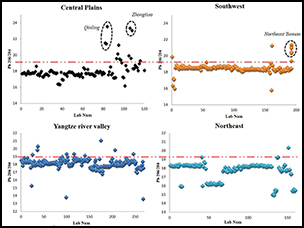Crossref Citations
This article has been cited by the following publications. This list is generated based on data provided by
Crossref.
Pollard, A.M.
Bray, P.
Hommel, P.
Hsu, Y.-K.
Liu, R.
and
Rawson, J.
2017.
Bronze Age metal circulation in China.
Antiquity,
Vol. 91,
Issue. 357,
p.
674.
Liu, Ruiliang
Rawson, Jessica
and
Pollard, A. Mark
2018.
Beyond ritual bronzes: identifying multiple sources of highly radiogenic lead across Chinese history.
Scientific Reports,
Vol. 8,
Issue. 1,
Liu, S. R.
Chen, K. L.
Rehren, Th.
Mei, J. J.
Chen, J. L.
Liu, Y.
and
Killick, D.
2018.
Lead isotope and metal source of Shang bronzes: a response to Sun et al.’s comments.
Archaeometry,
Vol. 60,
Issue. 5,
p.
1040.
2018.
ANNUAL BIBLIOGRAPHY.
Early China,
Vol. 41,
Issue. ,
p.
477.
Rawson, Jessica
2019.
Ordering the material world of the Western Zhou.
Archaeological Research in Asia,
Vol. 19,
Issue. ,
p.
100096.
Chen, Kunlong
Mei, Jianjun
Rehren, Thilo
Liu, Siran
Yang, Wei
Martinón-Torres, Marcos
Zhao, Congcang
Hirao, Yoshimitsu
Chen, Jianli
and
Liu, Yu
2019.
Hanzhong bronzes and highly radiogenic lead in Shang period China.
Journal of Archaeological Science,
Vol. 101,
Issue. ,
p.
131.
Chen, Dian
Luo, Wugan
and
Bai, Yunxiang
2019.
The social interaction between China and Japanese archipelago during Western Han dynasty: comparative study of bronze mirrors from Linzi and Yayoi sites.
Archaeological and Anthropological Sciences,
Vol. 11,
Issue. 7,
p.
3449.
Liu, Ruiliang
Pollard, A. Mark
Rawson, Jessica
Tang, Xiaojia
Bray, Peter
and
Zhang, Changping
2019.
Panlongcheng, Zhengzhou and the Movement of Metal in Early Bronze Age China.
Journal of World Prehistory,
Vol. 32,
Issue. 4,
p.
393.
Pollard, A. M.
Liu, R.
Rawson, J.
and
Tang, X.
2019.
From Alloy Composition to Alloying Practice: Chinese Bronzes.
Archaeometry,
Vol. 61,
Issue. 1,
p.
70.
Hsu, Yiu-Kang
Sabatini, Benjamin J.
and
Xia, Qun-Ke
2019.
A geochemical characterization of lead ores in China: An isotope database for provenancing archaeological materials.
PLOS ONE,
Vol. 14,
Issue. 4,
p.
e0215973.
Li, Haichao
and
O’Sullivan, Rebecca
2020.
Diachronic change in the Shang dynasty ritual package.
Archaeological Research in Asia,
Vol. 23,
Issue. ,
p.
100210.
Liu, Siran
He, Xiaolin
Chen, Jianli
Zou, Guisen
Guo, Shijia
Gong, Xicheng
and
Rehren, Thilo
2020.
Micro-slag and “invisible” copper processing activities at a Middle-Shang period (14th-13th century BC) bronze casting workshop.
Journal of Archaeological Science,
Vol. 122,
Issue. ,
p.
105222.
Chen, G.
Cui, Y.
Liu, R.
Wang, H.
Yang, Y.
Pollard, A. M.
and
Li, Y.
2020.
Lead isotopic analyses of copper ores in the Early Bronze Age central Hexi Corridor, north‐west China.
Archaeometry,
Vol. 62,
Issue. 5,
p.
952.
Killick, D.J
Stephens, J.A
and
Fenn, T. R.
2020.
Geological constraints on the use of lead isotopes for provenance in archaeometallurgy.
Archaeometry,
Vol. 62,
Issue. S1,
p.
86.
LIU, Cheng
LIU, Ruiliang
ZHOU, Pengcheng
LU, Chun
YANG, Zengxin
POLLARD, A. Mark
HOMMEL, Peter
MA, Jian
CUI, Jianfeng
BRAY, Peter
TONG, Jianyi
and
RAWSON, Jessica
2020.
Metallurgy at the Crossroads: New Analyses of Copper‐based Objects at Tianshanbeilu, Eastern Xinjiang, China.
Acta Geologica Sinica - English Edition,
Vol. 94,
Issue. 3,
p.
594.
Chen, Dian
Yang, Yingdong
Du, Jing
Tang, Xiang
and
Luo, Wugan
2020.
Alloy ratio and raw material sourcing of Warring States Period bronze bracelets in Huili County, Southwest China by pXRF and MC-ICP-MS.
Heritage Science,
Vol. 8,
Issue. 1,
LIU, Ruiliang
POLLARD, A. Mark
LIU, Cheng
and
RAWSON, Jessica
2020.
Every Cloud has a Silver Lining: Using Silver Concentration to Identify the Number of Sources of Lead used in Shang Dynasty Bronzes.
Acta Geologica Sinica - English Edition,
Vol. 94,
Issue. 3,
p.
585.
Li, H.
Gong, Y.
Cui, J.
Cai, Y.
Cai, Q.
Jiang, Z.
Zhou, Z.
and
Fan, J.
2021.
Imports or imitations?: Scientific and typological analysis of the bronze artefacts at the Moutuo Archaeological Site, Sichuan, China*.
Archaeometry,
Vol. 63,
Issue. 5,
p.
975.
Hsu, Yiu-Kang
O’Sullivan, Rebecca
and
Li, Haichao
2021.
Sources of Western Zhou lead: a new understanding of Chinese Bronze Age supply networks.
Archaeological and Anthropological Sciences,
Vol. 13,
Issue. 2,
Yan, Bichen
Liu, Siran
Chastain, Matthew L.
Yang, Shugang
and
Chen, Jianli
2021.
A new FTIR method for estimating the firing temperature of ceramic bronze-casting moulds from early China.
Scientific Reports,
Vol. 11,
Issue. 1,





